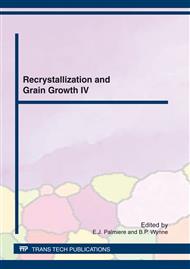p.329
p.333
p.334
p.340
p.346
p.354
p.360
p.361
p.367
Recrystallization in Ultra-Fine Grain Structures of AA3104 Alloy Processed by ECAP and HPT
Abstract:
The objective of this study was to determine the effect of deformation mode on recrystallization behavior of severely deformed material. Commercial purity AA3104 aluminum alloy was deformed via high pressure torsion and equal channel angular pressing to different strains and then annealed to obtain the state of partial recrystallization. The microstructure and the crystallographic texture were analysed using scanning and transmission electron microscopes equipped with orientation measurement facilities. The nucleation of new grains was observed in bulk recrystallized samples and during in-situ recrystallization in the transmission microscope. Irrespective of the applied deformation mode, a large non-deformable second phase particles strongly influenced strengthening of the matrix through deformation zones around them. It is known that relatively high stored energy stimulates the nucleation of new grains during the recrystalization. In most of the observed cases, the growth of recrystallized grains occurred by the coalescence of neighboring subcells. This process usually led to nearly homogeneous equiaxed grains of similar size. The diameter of grains in the vicinity of large second phase particles was only occasionally significantly larger than the average grain size. Large grains were most often observed in places far from the particles. TEM orientation mapping from highly deformed zones around particles showed that orientations of new grains were not random and only strictly defined groups of orientations were observed.
Info:
Periodical:
Pages:
346-353
Citation:
Online since:
April 2012
Authors:
Price:
Сopyright:
© 2012 Trans Tech Publications Ltd. All Rights Reserved
Share:
Citation:


